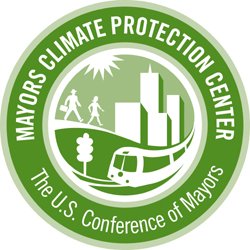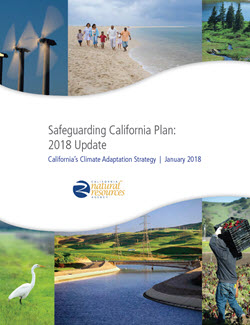Chico is the largest city in Butte County, with approximately 87,000 people living within the city limits and about 100,000 residing in the Chico urban area. Recognizing the impact of its GHG emissions on the northern portion of the Sacramento Valley, the City of Chico did not wait for state directives to address GHG emissions and climate change.
Following are some of the early steps the city has undertaken on its own accord.
Mayor’s Climate Protection Agreement
 In 2006, the City signed the U.S. Conference of Mayors’ Climate Protection Agreement (USCMCPA), adding Chico to a group of over 1,000 municipalities, 138 of which are in California, united in pledging to reduce greenhouse gas emissions.
In 2006, the City signed the U.S. Conference of Mayors’ Climate Protection Agreement (USCMCPA), adding Chico to a group of over 1,000 municipalities, 138 of which are in California, united in pledging to reduce greenhouse gas emissions.
Under the USCMCPA, Chico committed to take the following three actions:
- Strive to meet or beat the Kyoto Protocol targets through actions such as anti-sprawl land-use policies, urban forest restoration projects, and public information campaigns.
- Urge state and federal governments to enact policies and programs to meet or beat the GHG-emission reduction target suggested for the United States in the Kyoto Protocol.
- Urge the U.S. Congress to pass bipartisan GHG reduction legislation which would establish a national emission-trading system.
Formation of Sustainability Task Force
Signing the Mayors’ Climate Protection Agreement precipitated the creation of the Sustainability Task Force (STF) in 2007. Members of the STF represent various sectors of the community to provide input to the City Council on sustainability issues. One of the primary tasks of the STF is to assist the City in meeting the objectives of the Mayor’s Agreement and to conduct preliminary steps to develop a Climate Action Plan (CAP).
In preparation for drafting the CAP, the STF formed the following Ad-Hoc Committees: Outreach & Education, Sustainable Business Outreach, Innovators’ Pilot Outreach, Transportation Planning, and Climate Change Adaptation & Resiliency. The STF designated these Committees to focus resources on the development and implementation of specific components of the CAP, and to represent and promote these components throughout the community. These committees are comprised of STF members, city staff, representatives of institutions and utilities, and members of the general public.
City Measures that Address GHG Emissions by New Development
New development and redevelopment must adhere to a number of City policy documents, building code requirements, development standards, design guidelines, and standard practices that collectively further the goals and, in some cases, directly implement specific actions in the CAP. Below is a list of those measures which are applied on a project-by-project basis, and which aid in implementing the CAP:
- Consistency with key General Plan goals, policies, and actions that address sustainability, smart growth principles, multi-modal circulation improvements, and quality community design
- Compliance with California’s Title 24 Building Energy Efficiency Standards for Residential and Non-Residential Buildings
- Compliance with the City’s tree preservation ordinance
- Incorporation of street trees and landscaping consistent with the City’s Municipal Code
- Consistency with the City’s Design Guidelines Manual
- Consistency with the State’s Water Efficient Landscape Ordinance (AB 1881)
- Compliance with the City’s Residential Energy Conservation Ordinance, which requires energy and water efficiency upgrades at the point-of-sale, prior to transfer of ownership (e.g., attic insulation, programmable thermostats, water heater insulation, hot water pipe insulation, etc.)
- Provision of bicycle facilities and infrastructure as may be required by the City’s Bicycle Master Plan
- Installation of bicycle and vehicle parking consistent with the City’s Municipal Code
- Coordination with the Butte County Association of Governments to provide high quality transit service and infrastructure, where appropriate
- Consistency with the Butte County Air Quality Management District’s CEQA Handbook
- Adherence to Butte County Air Quality Management District mitigation requirements for construction sites (e.g., dust suppression measures, reducing idling equipment, maintenance of equipment per manufacturer specs, etc.)
- Requirement for new employers of 100+ employees to submit a Transportation Demand Management Plan
- Diversion of fifty percent (50%) of construction waste
- Compliance with the City’s Capital Improvement Plan, which identifies new multi-modal facilities and connections
- Option to incorporate solar arrays in parking areas in lieu of tree shading requirements
- Consistency with the City’s Storm Drainage Master Plan
Adaptation Planning for the Chico Area
 The State of California developed a plan for adapting to potential impacts of climate change entitled, 2009 California Climate Adaptation Strategy (the 2018 update is here). The Plan summarizes the best known science on climate change impacts in the state and outlines possible solutions that can be implemented within and across state agencies to promote resiliency
The State of California developed a plan for adapting to potential impacts of climate change entitled, 2009 California Climate Adaptation Strategy (the 2018 update is here). The Plan summarizes the best known science on climate change impacts in the state and outlines possible solutions that can be implemented within and across state agencies to promote resiliency
While it is important that the Chico community act quickly and boldly to reduce its contributions to GHG emissions, it is also necessary to simultaneously prepare for adaptation to regional changes that may result from climate change. Adaptation in this context means making long-term adjustments to maintain a level of community well-being, economic prosperity, and environmental quality in the face of changing circumstances. Effective adaptation will require local action that complements state initiatives, and early planning will significantly lessen the negative effects and costs of adaptation
To plan for the potential impacts of climate change, the Sustainability Task Force’s Adaptation and Resiliency Ad-Hoc Committee will developed a work plan consisting of three primary tasks
- Consider the range of potential impacts from climate change, and assess which will be the most prevalent in our local region
- Identify and engage key stakeholders, such as the local utilities and government agencies, within the City, Butte County, and the greater community in the process of addressing the impacts of climate change
- Develop a Climate Change Adaptation Plan for the Chico Area that outlines long-term strategies for mitigating anticipated local impacts of climate change. The Climate Change Adaptation Plan will be developed as a companion document to the Climate Action Plan.
The above language was taken from the City of Chico 2020 Climate Action Plan.

